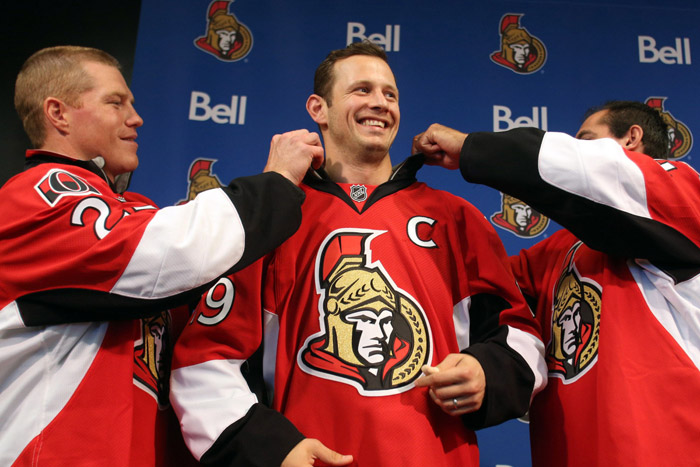When the Ottawa Senators appointed their superstar forward Jason Spezza captain one year ago, the response from the media was immediately critical.
Beat writers and columnists wrote that the Senators would never become a strong contender unless they parted ways with the ‘selfish’ Spezza. Fast forward one year: The Dallas Stars acquire Jason Spezza and winger Ales Hemsky in a trade from Ottawa. Suddenly, Dallas is considered a stacked team in a tough Central Division. A year later, once Spezza had moved to the Stars, the negative media stigma disappeared.
By portraying Spezza as a selfish, risky player who didn’t have the Senators’ best interests at heart, the otherwise standard procedure of appointing a captain was given loaded meaning. Conversely, focusing on his positive attributes in Dallas has allowed the media to strengthen the notion that the Stars are legitimate contenders. After Spezza’s one-year captaincy, Ottawa scribes linked his departure to Daniel Alfredsson’s the previous year to form a narrative surrounding the Senators’ lack of leadership.
Narratives are created by the media because of the human brain’s receptiveness to story as a way to understand and process information. Presenting a season’s ups and downs in the context of a storytelling framework triggers responses from emotionally engaged fans, serving to reel more fans into the sport. In tying common themes or introducing new plot twists, a compelling narrative can be crafted around a player, team, or season.This enables the media to create substance.
Storylines can be fascinating, but they can also be misleading. As illustrated by the Senators example, anything can be spun around and presented as a problem. This is most obvious in the stereotyping of players born outside of North America. Russian players are consistently labeled ‘enigmatic’ upon entering the league, which associates them with a lack of teamwork, inconsistency, and reticence. Unsurprisingly, they are in turn critiqued much more harshly. Xenophobic comments poured in when Edmonton Oiler Nail Yakupov showboated after a goal during the 2012-2013 season, including a harsh diatribe from Canada’s infamous talking head, Don Cherry. In framing Yakupov as a cocky, disrespectful young player, his on-ice production—arguably more important than his temperament—was obscured.
There are good narratives and bad narratives; using them well in sports writing helps make sense out of seasons, which can become chaotic when viewed as a whole. When Minnesota Wild goalie Josh Harding’s multiple sclerosis was revealed during the 2013-14 season, his battle was followed league-wide and recognized with the Bill Masterton Memorial Trophy at the season’s end. Occasionally, narratives can also be used to speculate about intangibles like leadership, ‘veteran presence,’ and chemistry. Because it’s difficult for fans to evaluate these factors for themselves, these storylines are highly influential. Presenting certain players as strong leaders in the locker room or a certain team as a tight-knit group isn’t easily contradicted by facts; there isn’t always an obvious right or wrong storyline.
But narratives aren’t necessarily the only way to write about sports. Take the weekly 30 Thoughts column by Elliotte Friedman. This is an excellent compilation of information and tidbits about various NHL-related issues, sourced through Friedman’s insider contacts. Although certain points may cover the same team, there is no clear overarching storyline. Evidently, it’s possible to approach sports without having to tell a forced story.
In the end, the validity of the narrative lies in the hands of the writer who creates it. Though stories may be second nature to us as humans, it remains important to critically examine the tendency to create narrative out of nothing.








